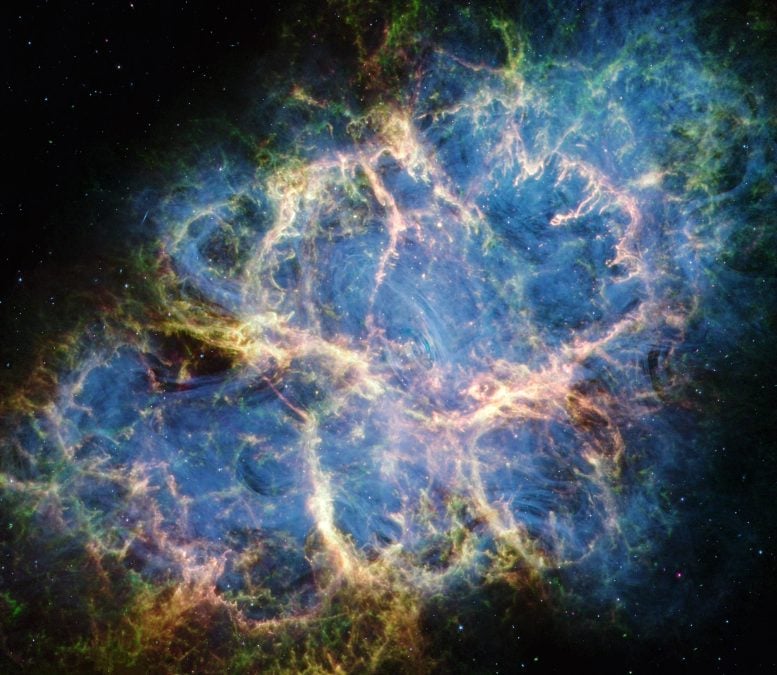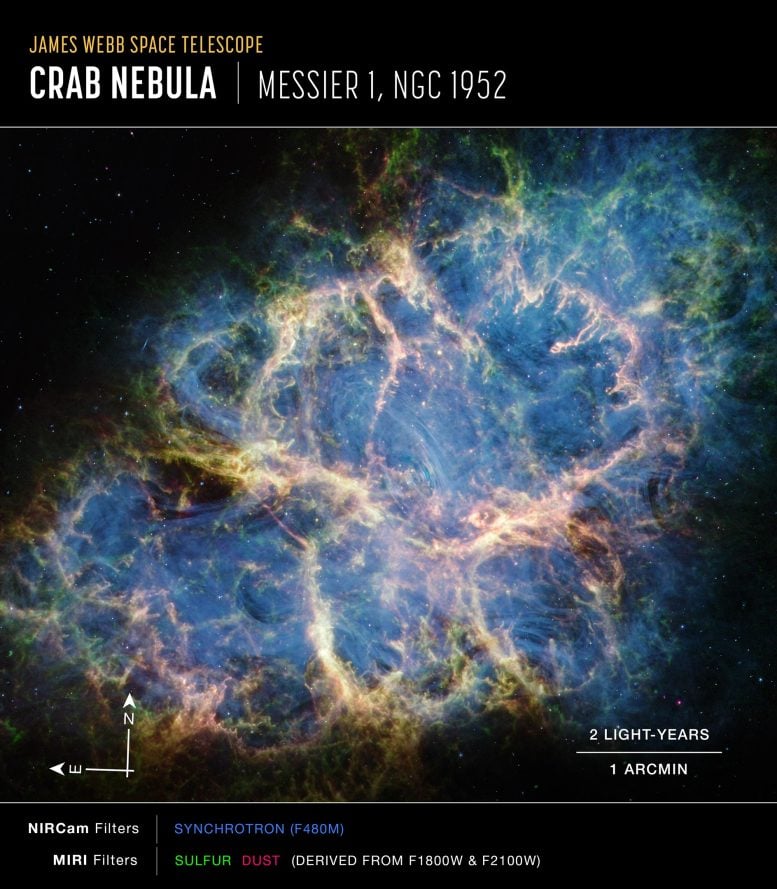NASA’s James Webb Space Telescope dissected the Crab Nebula’s structure, aiding astronomers as they continue to evaluate leading theories about the supernova remnant’s origins. With the data collected by Webb’s NIRCam (Near-Infrared Camera) and MIRI (Mid-Infrared Instrument), a team of scientists were able to closely inspect some of the Crab Nebula’s major components. Credit: NASA
New data revises our view of this unusual supernova explosion.
The Crab Nebula is a nearby example of the debris left behind when a star undergoes a violent death in a supernova explosion. However, despite decades of study, this supernova remnant continues to maintain a degree of mystery: What type of star was responsible for the creation of the Crab Nebula, and what was the nature of the explosion?

For the first time ever, astronomers mapped the warm dust emission throughout this supernova remnant. Represented as fluffy magenta material, the dust grains form a cage-like structure that is most apparent toward the lower left and upper right portions of the remnant. Filaments of dust are also threaded throughout the Crab’s interior and sometimes coincide with regions of doubly ionized sulfur (sulfur III) colored in green. Yellow-white mottled filaments, which form large loop-like structures around the supernova remnant’s center, represent areas where dust and doubly ionized sulfur overlap.
The dust’s cage-like structure helps constrain some, but not all of the ghostly synchrotron emission represented in blue. The emission resembles wisps of smoke, most notable toward the Crab’s center. The thin blue ribbons follow the magnetic field lines created by the Crab’s pulsar heart — a rapidly rotating neutron star.
Credit: NASA, ESA, CSA, STScI, Tea Temim (Princeton University)
Investigating the Origins of the Crab Nebula With the Webb Space Telescope
Using NASA’s James Webb Space Telescope, a team of scientists parsed the composition of the Crab Nebula, a supernova remnant located about 6,500 light-years away in the constellation Taurus. With the telescope’s 
Image of the Crab Nebula captured by Webb’s NIRCam and MIRI, with compass arrows, scale bar, and color key for reference.
The north and east compass arrows show the orientation of the image on the sky. Note that the relationship between north and east on the sky (as seen from below) is flipped relative to direction arrows on a map of the ground (as seen from above).
The scale bar is labeled in light-years, which is the distance that light travels in one Earth-year. (It takes 2 years for light to travel a distance equal to the length of the bar.) One light-year is equal to about 5.88 trillion miles or 9.46 trillion kilometers. The field of view shown in this image is approximately 10 light-years across.
This image shows invisible near-infrared and mid-infrared wavelengths of light that have been translated into visible-light colors. The color key shows which components were observed by NIRCam and MIRI, and which visible-light color is assigned to each feature.
Credit: NASA, ESA, CSA, STScI, Tea Temim (Princeton University)
Studying the Present to Understand the Past
Past research efforts have calculated the total kinetic energy of the explosion based on the quantity and velocities of the present-day ejecta. Astronomers deduced that the nature of the explosion was one of relatively low energy (less than one-tenth that of a normal supernova), and the progenitor star’s mass was in the range of eight to 10 solar masses — teetering on the thin line between stars that experience a violent supernova death and those that do not.
However, inconsistencies exist between the electron-capture supernova theory and observations of the Crab, particularly the observed rapid motion of the DOI: 10.3847/2041-8213/ad50d1
The observations were taken as part of General Observer program 1714.
The James Webb Space Telescope (JWST) is an advanced space observatory launched on December 25, 2021. It serves as the scientific successor to the



















![Where To Stay In Lagos [ Insider Tips ] Where To Stay In Lagos [ Insider Tips ]](https://paulinaontheroad.com/wp-content/uploads/2024/04/aerial-view-of-the-Boavista-Golf-Spa-Bela-Colina-Village-Lagos.jpg)
Discussion about this post